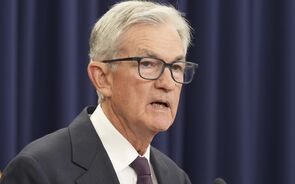As the Interest Rate Cycle Turns ...(Morgan Stanley)
2 mensagens
|Página 1 de 1
As the Interest Rate Cycle Turns ...(Morgan Stanley)
Joachim Fels & Elga Bartsch (London)
For some time we have argued that frothy bond markets had become too complacent about the outlook for further disinflation and thus also for official interest rates (EuroTower Insights: Bunds Back in Bubbly Waters, March 15, 2004). Yet over the last fortnight, markets have started to realise that the good times of maximum global monetary accommodation may soon be coming to an end. Following three years of continuous global monetary easing in response to the bursting of the equity bubble and its potentially deflationary consequences, excess liquidity appears to have done its job. Equity markets have recovered, companies have repaired their balance sheets and the global economy has rebounded. And the remaining fears about a relapse in the US economy and a related undesirable further drop in inflation have been soothed by a strong March labour market report and a jump in core consumer price inflation back right into the middle of the Fed’s 1-2% comfort zone. As our Chief Economist Steve Roach has been pointing out elsewhere, it is high time for the Fed and other central banks to reassess their policy stance in order to avoid a replay of the 1990s asset-price boom and bust cycle.
Some central banks are late in this game while others are ahead of it, depending on the weight they attach to asset prices relative to consumer prices in their policy deliberations, and depending on national economic conditions. At one end of the spectrum, the Bank of Canada, the Swedish Riksbank, and the Norwegian Norges Bank, have all been lowering rates until recently. On the other end of the spectrum, the Bank of England and the Reserve Bank of Australia have been ahead of the tightening game in an attempt to rein in surging house prices and the related risks for financial and economic stability. Yet the key question for financial markets remains if and when the Fed and the ECB will end their zero real-interest-rate policy. We continue to expect this to occur before the end of this year and, despite the recent back-up in bond yields, we think bond markets are not yet fully prepared for such an outcome.
Against this backdrop, the first week of May, which will see policy meetings of the Fed’s, the ECB’s and the Bank of England’s respective committees, is shaping up to be pivotal for financial markets.
First, it looks likely that the Fed, on May 4, will acknowledge the signs of labour-market improvement and will describe the inflation risks as no longer tilted to the downside but as being balanced now. While it is less clear whether the reference that monetary policy can be “patient” will be dropped, markets are likely to take such a shift in the language as confirming expectations that a rate hike in August or even as early as June is in the offing. Second, the Bank of England, on May 6, looks set to raise interest rates by 25 bp for the third time in this tightening cycle. While such a move is entirely discounted by markets, it may be seen by investors as a taste of things to come from the Fed and the ECB.
Third, but not least, the ECB’s statement and the press conference on May 6 will be watched even more closely, following the garbled message sent by ECB President Trichet after the April policy meeting. We expect no major change in the language from the last statement, which would keep the ECB in a wait-and-see attitude for a while, unless the economic data disappoint in a major way. The recent data from the euro area indicate that the sluggish recovery is on track and that inflation has bottomed for now and is likely to move back towards 2% in the next couple of months. Moreover, the combination of stronger US data, a slightly weaker euro, and increasing signs of fiscal laxity in the euro area will make it difficult for the advocates of rates cuts on the ECB Council to make their case. Money markets have moved to take out expectations of further ECB easing already and are now much closer to our own view that the next move in euro-area official interest rates is more likely to be up than down.
As the interest rate cycle turns, bond markets need to correct further, in our view. Despite the recent back-up in yields, 10-year Bund yields are still trading significantly below what we deem fair fundamental value of around 4.75%. Thus, as long as the ECB is on hold but markets move to price in the possibility of earlier and sharper Fed rate hikes, the euro area yield curve is likely to steepen. And with the Fed likely to move earlier than the ECB and having a longer way to go towards a neutral stance, euro-area bonds should outperform US bonds.
For some time we have argued that frothy bond markets had become too complacent about the outlook for further disinflation and thus also for official interest rates (EuroTower Insights: Bunds Back in Bubbly Waters, March 15, 2004). Yet over the last fortnight, markets have started to realise that the good times of maximum global monetary accommodation may soon be coming to an end. Following three years of continuous global monetary easing in response to the bursting of the equity bubble and its potentially deflationary consequences, excess liquidity appears to have done its job. Equity markets have recovered, companies have repaired their balance sheets and the global economy has rebounded. And the remaining fears about a relapse in the US economy and a related undesirable further drop in inflation have been soothed by a strong March labour market report and a jump in core consumer price inflation back right into the middle of the Fed’s 1-2% comfort zone. As our Chief Economist Steve Roach has been pointing out elsewhere, it is high time for the Fed and other central banks to reassess their policy stance in order to avoid a replay of the 1990s asset-price boom and bust cycle.
Some central banks are late in this game while others are ahead of it, depending on the weight they attach to asset prices relative to consumer prices in their policy deliberations, and depending on national economic conditions. At one end of the spectrum, the Bank of Canada, the Swedish Riksbank, and the Norwegian Norges Bank, have all been lowering rates until recently. On the other end of the spectrum, the Bank of England and the Reserve Bank of Australia have been ahead of the tightening game in an attempt to rein in surging house prices and the related risks for financial and economic stability. Yet the key question for financial markets remains if and when the Fed and the ECB will end their zero real-interest-rate policy. We continue to expect this to occur before the end of this year and, despite the recent back-up in bond yields, we think bond markets are not yet fully prepared for such an outcome.
Against this backdrop, the first week of May, which will see policy meetings of the Fed’s, the ECB’s and the Bank of England’s respective committees, is shaping up to be pivotal for financial markets.
First, it looks likely that the Fed, on May 4, will acknowledge the signs of labour-market improvement and will describe the inflation risks as no longer tilted to the downside but as being balanced now. While it is less clear whether the reference that monetary policy can be “patient” will be dropped, markets are likely to take such a shift in the language as confirming expectations that a rate hike in August or even as early as June is in the offing. Second, the Bank of England, on May 6, looks set to raise interest rates by 25 bp for the third time in this tightening cycle. While such a move is entirely discounted by markets, it may be seen by investors as a taste of things to come from the Fed and the ECB.
Third, but not least, the ECB’s statement and the press conference on May 6 will be watched even more closely, following the garbled message sent by ECB President Trichet after the April policy meeting. We expect no major change in the language from the last statement, which would keep the ECB in a wait-and-see attitude for a while, unless the economic data disappoint in a major way. The recent data from the euro area indicate that the sluggish recovery is on track and that inflation has bottomed for now and is likely to move back towards 2% in the next couple of months. Moreover, the combination of stronger US data, a slightly weaker euro, and increasing signs of fiscal laxity in the euro area will make it difficult for the advocates of rates cuts on the ECB Council to make their case. Money markets have moved to take out expectations of further ECB easing already and are now much closer to our own view that the next move in euro-area official interest rates is more likely to be up than down.
As the interest rate cycle turns, bond markets need to correct further, in our view. Despite the recent back-up in yields, 10-year Bund yields are still trading significantly below what we deem fair fundamental value of around 4.75%. Thus, as long as the ECB is on hold but markets move to price in the possibility of earlier and sharper Fed rate hikes, the euro area yield curve is likely to steepen. And with the Fed likely to move earlier than the ECB and having a longer way to go towards a neutral stance, euro-area bonds should outperform US bonds.
- Mensagens: 195
- Registado: 11/12/2002 2:48
- Localização: Paço de Arcos
2 mensagens
|Página 1 de 1
Quem está ligado:
Utilizadores a ver este Fórum: Bing [Bot], Pmart 1 e 62 visitantes


